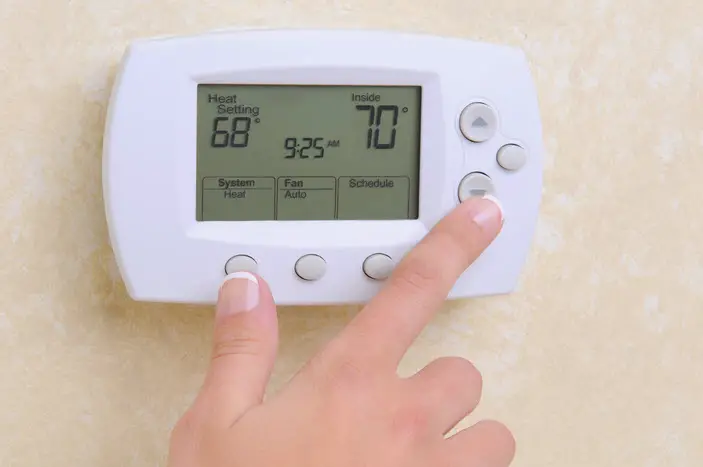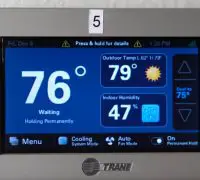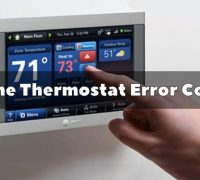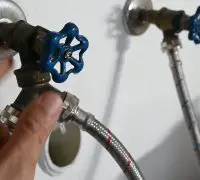Now that winter is just around the corner, and you will want to feel warm inside your house more often. Even if you have prepared your heating furnace for winter, some problems may occur all of a sudden. For instance, you may set your furnace at 72 f degrees and realize that the room temperature still doesn’t match the thermostat setting. Most of the time, a damaged or broken sensor is the main reason why the thermostat isn’t able to get to the temperature you want.
However, an affected sensor isn’t the only cause for which your thermostat reads higher or lower, and some other aspects may cause this kind of problem. Make sure that you stay cautious and apply our suggestions to your specific model of the heating furnace. The variety of thermostats models is quite impressive, so covering the main characteristics can ease out the fixing.
Side note
When the furnace runs continuously, and the room temp still doesn’t match your thermostat setting, some of the other elements may be the problem. Check the filter to see that it’s clean. Should you use an ac, the outdoor and indoor coils have to be clean for proper operation. If cleaning sounds too much work for you, you can call the HVAC technician. You will pay somewhere between $75 and $200 for that kind of service.
Page Table of Contents
Which type of thermostat do you have?
The market provides several types of thermostats, and you should know which type you have before trying to fix the problem. Here are the primary kinds of thermostats at the moment:
Smart thermostats
These are the most complicated thermostats on the market today. They come with numerous features that ease out the use and provide accurate operation. However, fixing a smart thermostat isn’t a DIY project, so try your best not to fix it unless you’re good with electrical stuff.
Smart thermostats are great as they can come with features for zone control, wi-fi compatibility, voice command, touch screen. These features provide the most customized use of heating in your house, saving energy at the same time.
Programmable digital thermostats
When you’re using a programmable digital thermostat, you will be able to control the amount of energy you utilize throughout the day. You plan the time you wish the HVAC system to begin to run, choosing the temperature you want to have inside. You may always have different times and temperatures, but you have to reset the program to make the changes.
Non-programmable digital thermostats
As the name suggests, these thermostats only allow manual modification for the HVAC system temperatures. It’s not possible to program the heating furnace, but these thermostats are more straightforward and more comfortable to fix, in theory, at least.
Programmable mechanical thermostats
You won’t see many programmable mechanical thermostats nowadays as these models are quite old. These are non-digital models that ensure elementary HVAC settings for the user.
Even if they’re the most affordable type of thermostats, they’re also the most straightforward and least durable model. They come with a mercury switch to complete the circuits, and many states have already forbidden the use of these thermostats for safety reasons.
What are the typical factors for the thermostat not achieving the set temp?
As we’ve already mentioned, some factors are prevalent, but various aspects may also affect the thermostat’s proper operation. Keep reading for the details.
Dirty thermostat& loose wiring
Sometimes, the cause of the problem is less complicated than you may think. A dirty thermostat won’t be capable of reaching the desired temperature. The lint or dust may deposit inside the thermostat, blocking the sensors. Soon enough, the room temperature won’t match the thermostat setting, and it’s some dust causing the problem.
What’s the fix?
You need to do some cleaning. Begin with removing the thermostat faceplate and use a cloth/soft tip brush to remove the collected dust. Even if thermostats are so different, you should always manage them gently as they have fragile elements that you may damage while cleaning.
Even if it’s tempting, don’t use the vacuum cleaner on the thermostat. No matter how low the setting on your vacuum cleaner may look, the suction will still be too strong for the fragile elements inside the thermostat. Not only that, you will damage the delicate parts, but you may also suck one of the tiny details inside.
If cleaning with a brush or cloth seems not useful for you, you may utilize canned air instead.
Loose wiring
Loose wiring goes together with a dirty thermostat. More often than not, the two problems come together as lint and corrosion collected inside can loosen the wiring where it’s connected. After some time, the buildup will affect and even block the electrical current entirely from running.
What’s the fix?
Once again, you take a brush for removing dust and a cotton swan for the more challenging to reach areas. You will need a swan for removing corrosion. Once you’re done with cleaning, take a thorough look to see if everything is screwed tight and safely plugged in.
If cleaning the thermostat doesn’t solve the problem, you may deal with a more severe issue. A brush or some cloth won’t fix the problem, though.
Unleveled thermostat& wrong location
It doesn’t have to be a severe problem with your thermostat for it not to operate correctly. Even if some aspects like proper installation may seem minor, they can make your thermostat not reach the set temperature.
When your thermostat isn’t flush with the wall, it will develop the wrong temperature reading. It may be that the wall is uneven (you won’t be able to solve that in a second) or the thermostat may not be correctly installed. Either way, the lousy pin connection between the backplate and the thermostat will cause improper reading. Unless you fix the pin connection, the thermostat won’t be capable of adequately achieving the room temperature or heating your household.
What’s the fix?
Proper reading is possible only when the backplate is squared to the wall. You should begin removing the thermostat faceplate, loosening the screws that connect the backplate to the wall until the backplate becomes squared. You should replace the thermostat faceplate and observe if that fixed your problem.
Sometimes, simply not installing the thermostat in the right place can affect its operation. Should the thermostat be mounted in a hot zone of your house (fireplace, an area with numerous lights, or w near a window with regular sunshine), the temperature reading will always be higher than other parts of your house.
Mounting the thermostat in colder areas of the house (drafty hallway, close to an exterior door, or on an outer wall) isn’t a good idea either. The thermostat will always read a colder temp than what’s in most of your house.
What’s the fix?
You should always carefully install the thermostat, with consideration to the location. You should also maintain the window shades closed, control how often use the outside door, and not mount the thermostat close to appliances that get hot like hair dryers. Placing the thermostat on an exterior wall is rarely a good idea, mostly if the climate affects the thermostat’s operation. You should call the HVAC professional for proper mount inside the house.
Damaged/broken sensors
Your thermostat is capable of identifying the temperature in your house, thanks to the built-in sensor. When the sensor is damaged or malfunctioning, the thermostat may read higher or lower than your temp setting. As the thermostats are different, it makes sense that they also use different kinds of sensors:
Smart thermostats
These models come with remote-controlled sensors that you may monitor with your smartphone apps and wi-fi.
Programmable/non-programmable digital thermostats
These models come with a solid-state temperature sensing device, also known as a thermistor. The thermistor is an electrical resistor capable of changing the physical resistance when exposed to temperature changes.
Mechanical thermostats
The mechanical thermostats come with bi-metal strips made with two various metals (nickel and copper, for example) connected. An alternative sensor (gas-filled bellows) can also be utilized for mechanical thermostats.
What’s the fix?
Should the sensor be damaged, it’s anything but effortless to fix the thermostat. It’s a lot easier to replace the thermostat than repairing the sensor.
The first step will be switching the thermostat from the “auto” to the manual model. A professional HVAC can help you with the replacement, but you can do it too if you’re following the steps from a thermostat replacement guide. As different models request different steps to take, you should check the user manual from your thermostat for a replacement guide.
Recalibration is needed
New thermostats come with your pre-adjusted settings, so you will have to make other settings according to your needs. But it doesn\t mean that the thermostat will keep the neighborhoods stills.
There are several situations in which the thermostat may lose calibration.
- Batteries die
Not all thermostats come with batteries, but ones that do will need new batteries after some time.
What’s the fix?
When the thermostat runs on batteries, you may simply replace the current batteries with new ones and see if you fixed the problem.
- The device has just been mounted/it’s a non-programmable digital thermostat.
It’s relatively common for new thermostats to have difficulties identifying the room temperature, even if they’ve been recalibrated. Needless to say, you have to be 100% sure that the thermostat matches your HVAC system.
As they don’t come with programmable functions, the manual/non-programmable digital models are sensitive to external factors, like opening an outside door. They cause inaccurate readings, so switching to better models is the best solution.
Tip
You may easily see if the thermostat’s temperature sensor works correctly by taping a precise thermometer close to the thermostat. Let them sit together for 15 minutes and check both the thermometer and the thermostat; if it’s the same reading, you’re good to go. If not, recalibration of the thermostat will be necessary.
What’s the fix?
You have to recalibrate the new thermostat or non-programmable thermostat. Every model comes with specific steps to follow for recalibration, so always check the user manual. If you have a non-programmable thermostat, the recalibration will be necessary more often.
Now it’s a good time to switch to a programmable digital model. It will be cos you more, but programmable models don’t lose the calibration that easily.
- Electrical problem
It’s not common for a thermostat to lose calibration because of electrical issues, but it’s not impossible. Fixing the electrical problems isn’t a DIY project, so you should call the HVAC technician.
Uneven mercury switch
For the programmable mechanical thermostats, recalibration is a bit tricky. When a mechanical thermostat reads higher than the set temperature, the mercury could be vial as the mercury switch isn’t entirely straight.
The mercury switch is placed inside horizontally. Any tilting will impact the precision of the thermostat, and recalibration is needed.
What’s the fix?
It would help if you started removing the faceplate of the thermostat for checking the glass mercury switch. When it’s not lying completely horizontally, you may need even it with your hand or a level to straighten it.
As the switch contains mercury, you should always be extra careful when managing the button. Touching the mercury will poison you; it’s the main reason some states banned using this type of thermostat anyway.
Heat anticipator problems
Mechanical thermostats operate with the use of a heat anticipator, which is basically an electrical resistor device. It’s a tiny disc with resistive heat wire and an adjustable arm with a pointer on end. The anticipator will set the point at which the thermostat will shut off the furnace’s burners, stopping them right before achieving the room temperature.
An offset anticipator will make the thermostat incapable of stopping at the desired temperature, causing the room temp higher than planned.
What’s the fix?
Remove the faceplate to take a good look at the anticipator. The resistor disc typically comes with a “long cycle” reading with calibration marks surrounding the disc. Push the adjustment arm carefully close to the “longer” word. Your furnace may have to run through a couple of cycles to make the change.
If your heating furnace still cannot achieve the set temperature, rending the temperature too high or too cold, you may slowly move the adjustment arm one or two calibration spots in the opposite direction. Wait again two or three furnace cycles until the furnace makes the necessary adjustments.
Repeating the process several times will be necessary, most of the time. However, when you still don’t succeed, have the thermostat reach the set temperature; replacing the thermostat could be the best solution.
What are the other common causes?
Several situations may also make the thermostat reach the set temperature, so scroll down for a better explanation.
Size of thermostat
Sometimes, the size of the thermostat may cause an unpleasant situation. When the thermostat temperature is too small for your home or not made to cover your home’s size, it will only not reach the set temp.
What’s the fix?
It goes without saying that the thermostat’s size should match your house’s size. Call the HVAC technician when you have no idea about the proper size.
The fan does not work correctly.
The fan of the thermostat can also cause improper functioning. The relation between the furnace and the fan is essential for the thermostat’s proper operation, so you should also check it when the thermostat doesn’t reach the desired temperature.
What’s the fix?
Turn off the fan after switching off the furnace for two minutes. Otherwise, the fan will keep pushing cold air, affecting the thermostat’s balance throughout the process.
The thermostat is frozen.
Modern thermostats are smart, and static electricity can affect the proper operation of the touch screen. Therefore, the thermostat’s display could freeze and not send a necessary data update on the screen. If so, the thermostat won’t achieve the set temperature, but you won’t even see it on display.
What’s the fix?
Rebooting the thermostat is the easiest to fix the problem. Turn it off for a couple of seconds, wait, and turn it back on to see if you’ve repaired it.
One piece of advice
Sometimes, a simple cause like losing power could make the thermostat not reach the set temperature. A dark or blank thermostat has lost control, and you won’t be able to check the status on the screen. The furnace or the condenser doesn’t work either as they don’t have power.
Take a walk around the house to see if other electrical devices don’t have power as well. If they don’t have power, you can call the electrical company to see what’s wrong. No electrical device will operate when the power is off, right? (battery-operated devices excluded!)






